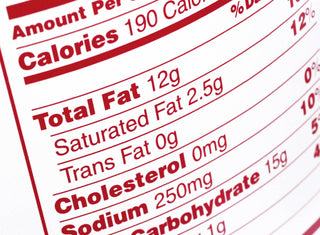A lot of people think that exercise is the be-all and end-all to maintaining or losing weight, but this misconception is often based on slick marketing by – surprise – the food industry. The real key to weight loss? Eating fewer calories.
Think about it. Instead of working out for 3 hours to burn off the burger you had for lunch, you can skip the burger and choose a healthy option with fewer calories. By simply being mindful and choosing good-for-you foods like high-fiber fruits, vegetables, and whole grains, as well as lean meats, you can easily cut calories.
It’s helpful to count calories first to get an idea of how many you’re getting on a regular basis. A lot of foods we consider “diet foods” have more calories than we think, and even the condiments we use can add up quickly.
Tracking what you’re eating is easy with the wide variety of free apps available, like MyFitnessPal (iOS, Android) and Lose It! (iOS, Android). Your phone is always with you – why not use it as a tool to help you count calories and improve your body?
10 Best Weight Management Tools
So now that you know how many calories you’re consuming, how do you figure out how many calories you need? That depends on your weight, sex, and physical activity levels.
Basal Metabolic Rate
Basal Metabolic Rate (BMR) is how many calories you burn doing nothing. Well, not nothing exactly. Your body uses energy for its most basic functions, including breathing and blood circulation, and that amount of energy is your BMR. And surprisingly, your BMR accounts for about 70 percent of your daily calories burned.
A few factors affect your BMR, including:
Size and body composition. The more mass you have, the more calories you burn. This includes having more muscle mass, which increases your BMR. Conversely, when you lose weight, you burn fewer calories.
Sex. Men usually have less body fat and more muscle than women of comparable age and weight, so they burn more calories.
Age. As you age, you tend to lose muscle (about 5-10% every 10 years after age 30), which slows your calorie burning ability. This is why strength training is important to maintain muscle mass because you don’t want to lose strength and gain fat as you age.
Weight Training Best For Keeping Weight Off
You can get an estimate of your BMR, using a formula called the Mifflin-St. Jeor equation.
Resting Metabolic Rate using Mifflin St. Jeor Equation :
For Men : 10 x weight (kg) + 6.25 x height (cm) - 5 x Age + 5
For Women : 10 x weight (kg) + 6.25 x height (cm) - 5 x Age - 161
The good news is that you don't need to do any math; just enter in your age, height, weight and activity levels here and your BMR will be calculated.
Physical Activity Level
How active you are also affects the number of calories you need. Understandably, people who are sedentary aren’t likely to burn as many calories as those who are extra active. But, activity levels can boost your caloric intake from a low of 20% to a high of 75%.
Total Energy Expenditure
So by multiplying your estimated BMR and your physical activity factor, you can calculate your Total Energy Expenditure, or TEE – the total calories you burn each day. This figure is how many calories you need to maintain your current weight, so if you wanted to lose weight, you would need to consume fewer calories than your TEE.
For example, a 5 feet 4 inch tall woman, weighing 165 pounds, who is 48 years old and engages in little or no exercise has a TEE of 1,640 calories. However if she engages in moderate exercise 3 to 5 times a week, her TEE is boosted to 2,117 calories a day.
For her to stay at 165 pounds at the same physical activity level, she would need to consume 1,640 calories each day. If she wanted to lose weight? She could reduce her caloric intake to below 1,640 calories daily and help boost that calorie deficit by being more active.
Thermal Effect of Food. And don’t forget about the importance of the type of food you eat. Not all calories are the same, especially as the body processes them. It takes more energy to process protein - 20 to 35% of the total calories, in fact - and 5-15% of carbohydrate calories are burned processing, with high-fiber foods being the most efficient. Fats fall flat, burning anywhere from 0-5% of calories. So as you watch your calories, take this into consideration and choose your foods wisely.
Do the math and calculate how many calories you should be eating for your ideal weight – you’ll find a little subtraction can add and multiply a number of health benefits!

